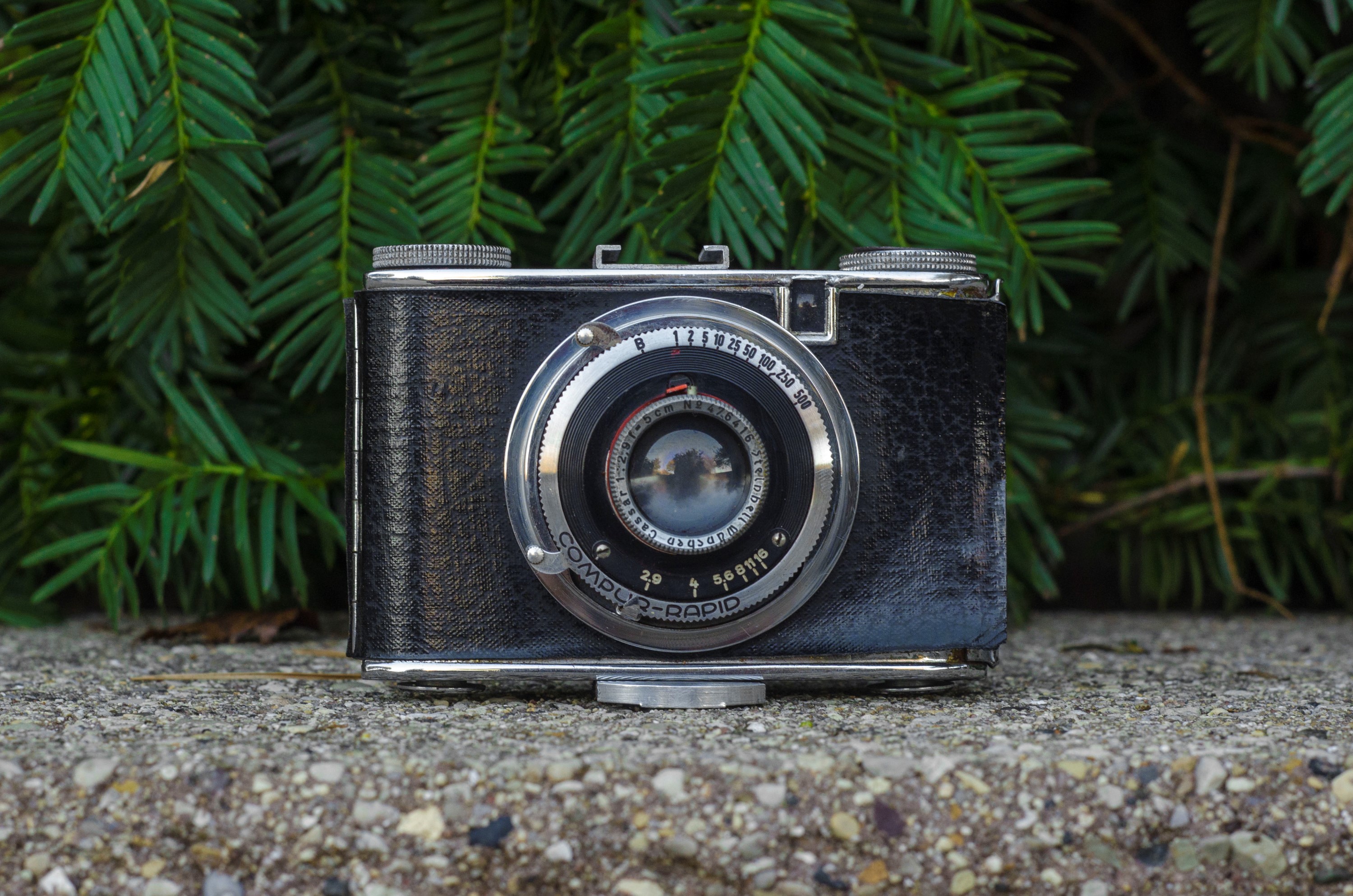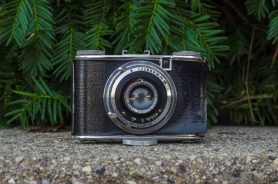 This review is part of the Cameras of the Dead series which I have been publishing every year on Halloween and “Halfway to” Halloween, featuring three cameras that I’ve wanted to review that either didn’t work, or was otherwise unable to shoot.
This review is part of the Cameras of the Dead series which I have been publishing every year on Halloween and “Halfway to” Halloween, featuring three cameras that I’ve wanted to review that either didn’t work, or was otherwise unable to shoot.
I am republishing each of those individual reviews this October in anticipation of this Halloween’s Cameras of the Dead post as a way to revisit the cameras of the past that allows them to be properly indexed on the site.
This is an Ising Puck, a compact and elegantly designed half-frame 127 roll film camera that was made between the years of 1948 and 1950. The Puck has a collapsible lens tube and is often found with Prontor or Compur shutters with mid-level lenses by Steinheil München, Staeble Kata, or Rodenstock suggesting it was probably a mid-range model, but I can’t really be sure of much more than that.
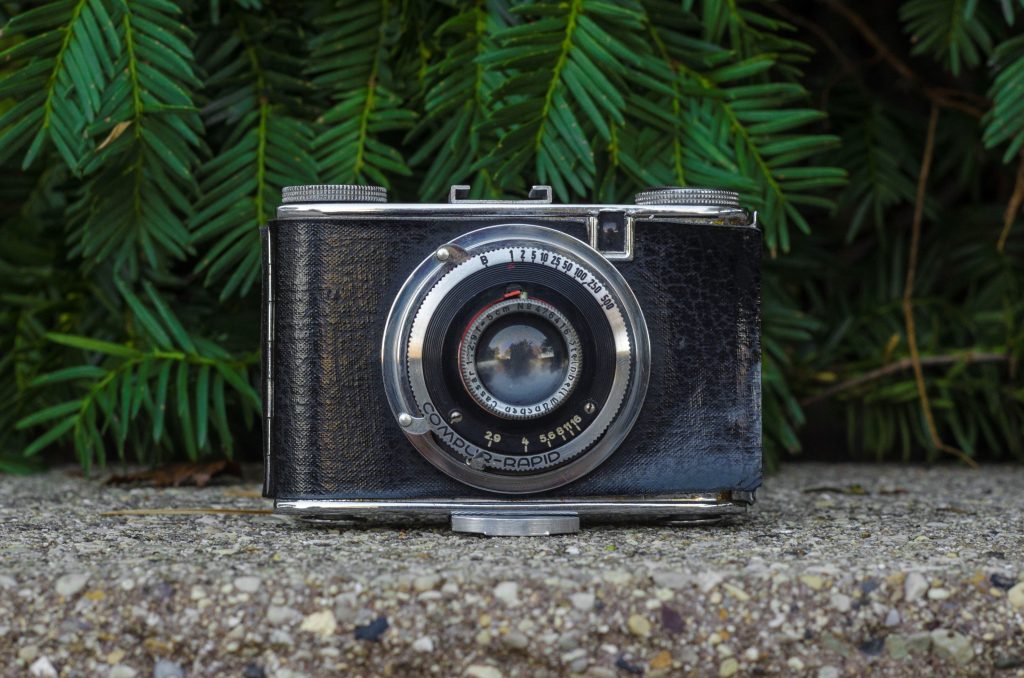 Film Type: 127 Roll Film (sixteen 3cm x 4cm exposures per roll)
Film Type: 127 Roll Film (sixteen 3cm x 4cm exposures per roll)
Lens: 5cm f/2.9 Steinheil München Cassar coated 3-elements
Focus: 0.9m to Infinity
Viewfinder: Scale Focus Optical Finder
Shutter: Compur-Rapid Leaf on a Collapsible Tube
Speeds: B, 1 – 1/500 seconds
Exposure Meter: None
Battery: None
Flash Mount: Coldshoe and FP Flash Sync
Manual: None
My Thoughts
The Ising Puck is one of the most mysterious cameras in my collection as it was made by a company that I found almost no information on. Even short lived companies like Clarus, Detrola, or Aires have more complete histories on the Internet. Very little is known about the Ising Camera Company other than it was founded by a man named Eugen Ising in Bergneustadt, Germany.
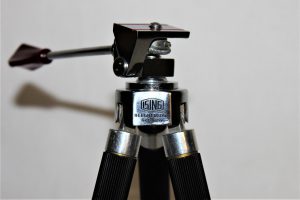
The Ising company may have originally started out making photographic accessories such as tripods in the 1920s, but that is about all I could find online. If you search Google enough, a fair number of Ising tripods will show up. Ising also made a small number of other cameras like the Isis and Pucky, but the company seemed to disappear around 1954.
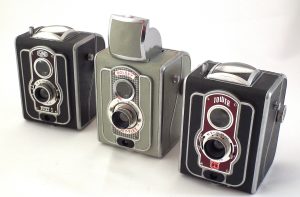
Towards the end of the company’s existence, Ising must have developed some sort of relationship with an American distributor as one of their models, the Ising Pucky, was rebadged and sold as the Bolsey Bolseyflex, and the Sears Tower 120 Flash. The image to the right shows all three variants side by side.
Beyond this, there is nearly no other information of the Ising company, their origins, and what became of them. The Puck was likely the company’s highest end model as their other known models were very basic and likely sold for very little. By the 1950s, the dominance of the German camera industry was being superseded by Japan, so it’s plausible that the market simply dried up. The company’s headquarters in Bergneustadt was located in what was then West Germany, and it is likely that the weak post-war Germany economy contributed to it’s demise.
I had never heard of the Puck or even the Ising company for that matter before spotting this camera in an antique shop sitting in a leather case with the name AGFA embossed on it. The little tag accompanying the camera called it an AGFA Puck, and quick research on my phone didn’t turn anything up, so I brought the camera home for the low, low price of $10. It was not until later that I realized the true identity of the camera.
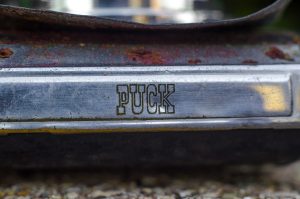
The Puck was very dirty and in poor cosmetic condition with several strips of body covering missing from the top and bottom of the camera. The main parts of the body were peeling badly. The good news was that the Compur shutter was in working order, even down to 1 second, so that suggested I likely could have shot some film in it.
Of the three cameras featured in this edition of Cameras of the Dead, the Puck is the only one I could have somewhat easily shot, since 127 film is available. It had been sitting in a box of junk for over a year before stumbling upon it and in that time, the desire never came over me to bother putting any film it, so I figured I would just feature it here. Knowing the reputation of Steinheil München Cassar triplets and Compur shutters, I could likely predict that any images shot through the Puck would have looked pretty good. At least as good as those shot with the Foth Derby, which was another capable German built half frame camera that used 127 film.
The in-body optical viewfinder and collapsible lens tube helps keep the camera quite small. When placed side by side with an Olympus XA2, the main part of the body is almost exactly the same width, but the Puck is about a quart of an inch taller. Back to front, the Olympus is still narrower, even with the Puck’s lens in the collapsed position.
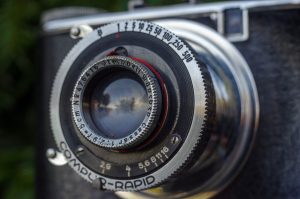
All of the camera’s controls are on the shutter itself, so there is no top plate shutter release, or any type of coupled double exposure prevention. You must remember to advance your film after each shot and cock the shutter before taking the next one. The viewfinder is extremely tiny and is not parallax corrected, so you’d need to adjust your compositions when focusing on things close to the camera.
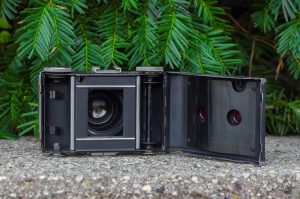
Film loads in the back of the camera from right to left, and you must use both red windows on the back to properly space each half frame of 127 film. Like most half frame 127 cameras like the previously mentioned Foth Derby and Kodak Vollenda, you must use each window twice since 127 film only had exposure markings for “full frame” 8 exposure cameras.
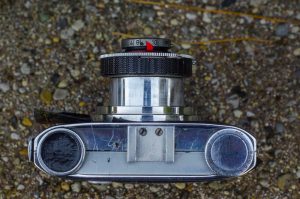
Although there is an accessory shoe on top of the camera, I see no other provision for flash, not even on the shutter itself. This shoe was likely used for accessory rangefinders or light meters, rather than for flash photography. Next to the accessory shoe is an uncoupled depth of field calculator. This calculator looks very similar to the ones Kodak AG would have used on many of their folding cameras of the era. The only other notable feature of the camera is the fold out kickstand on the bottom of the camera that helps support the camera when sitting on a flat surface with the lens extended.
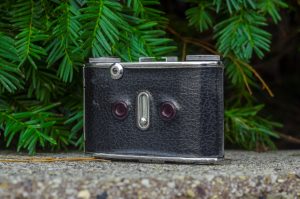
The Ising Puck is an all metal camera that predates the widespread use of plastics in inexpensive cameras, and without film loaded weighs 367 grams. The build quality of the camera is quite good, and the inclusion of the Compur Rapid shutter and decent triplet lens suggests this camera probably competed with cameras like the Wirgin Edinex or possibly even entry level Kodak Retinas.
Considering the huge variety of cameras available when this model was being sold, I don’t know why anyone would have chosen the Puck, or even how many were built. The lack of many available on the used market and the fact that the company came and went so quickly suggests few did.
In any case, the Ising Puck is a pretty neat little camera that looks a little different from other cameras made in the late 40s and early 50s. Mine is in pretty rough condition, but I would bet that an example in nicer shape would be an excellent addition to any collection. Had I chosen to shoot some film in this camera, my guess is I would have likely been happy with the results.
Edit 6/15/19: Fellow collector and good friend of mine, Dan Arnold recently told me about an Ising Puck he had acquired and was shooting some film through. Dan shot two rolls of film, an expired roll of Efke Black and White 127 film, and some bulk 46mm Fujifilm Pro160S film that Dan cut and spooled to 127.
Here is a gallery of Dan’s Puck along with a couple of his sample pics. I must say, that after seeing these, I both need to look into some bulk 46mm color film, but that I should also dig out my Puck from whatever crypt it resides in my basement, and see if I can revive it!
Related Posts You Might Enjoy
External Links
http://camera-wiki.org/wiki/Puck
https://knippsen.blogspot.com/2019/09/ising-puck.html
http://www.collection-appareils.fr/x/html/camera-6157-Ising_Puck.html

